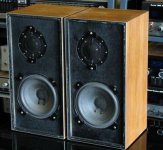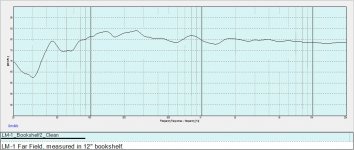Dear DIY'ers,
Just to let you know I have completed the design on the 2-way LM-1 speakers. The cost to build is around $500/pair with cabinets. It uses the famous Vifa XT25 ring radiator along with a 5.25" Peerless woofer in a ported enclosure. The complete project information and cabinet drawings can be found from my blog page here.
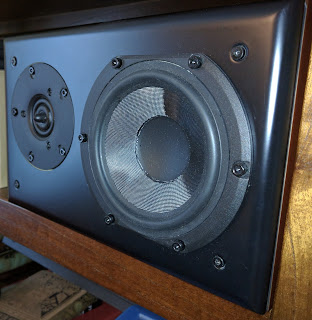
The FR is missing the port, which will be true until after I move, but the far-field data indicates usable output to 50Hz.
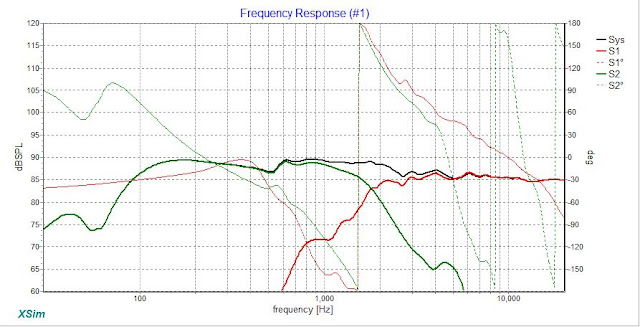
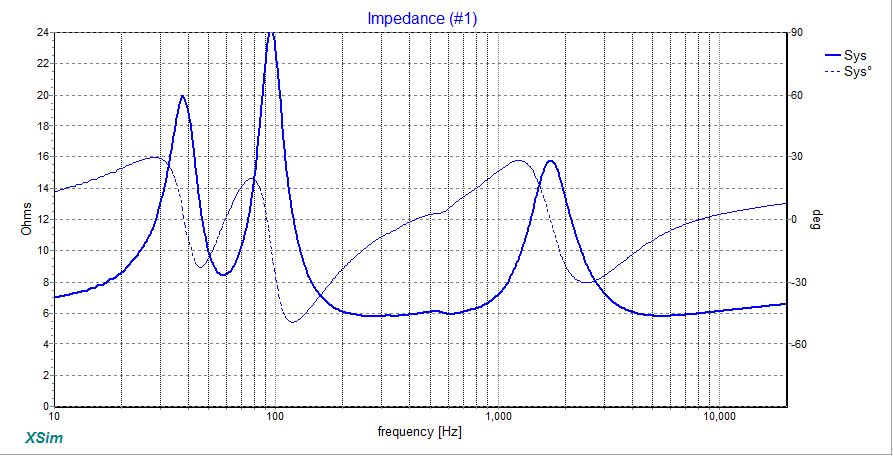
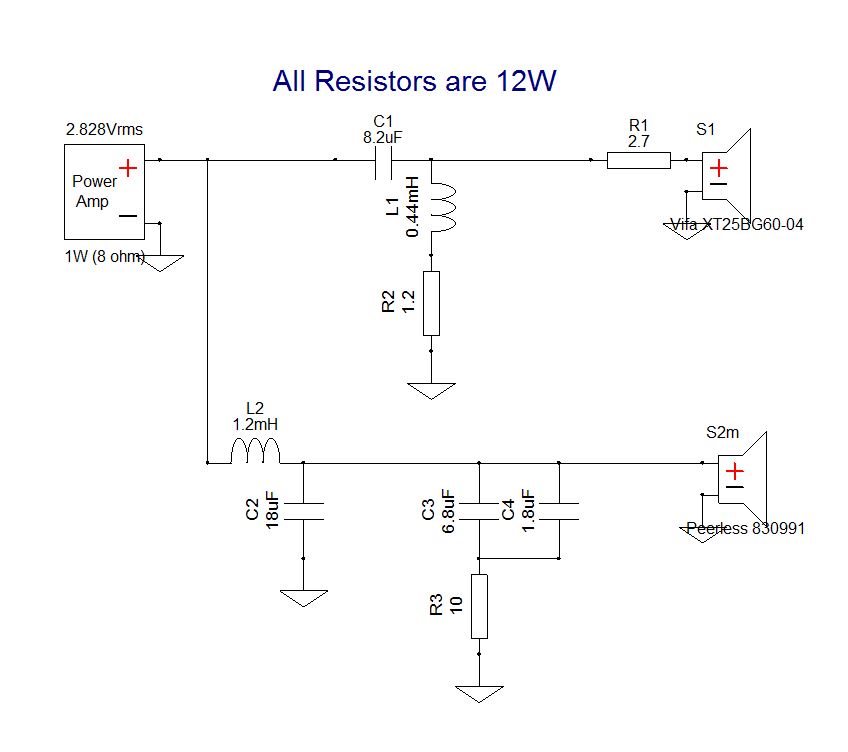
Just to let you know I have completed the design on the 2-way LM-1 speakers. The cost to build is around $500/pair with cabinets. It uses the famous Vifa XT25 ring radiator along with a 5.25" Peerless woofer in a ported enclosure. The complete project information and cabinet drawings can be found from my blog page here.

The FR is missing the port, which will be true until after I move, but the far-field data indicates usable output to 50Hz.



I agree that the TG30 will not do what you're asking of the BG60.
Was the design intended for sideways positioning then?
Wolf
Hi Wolf,
Call it creative photography.
Best,
Erik
Last edited:
Hi Everyone!
Instead of packing, I have been tweaking the LM-1 to the B&K reference curve. I personally like that curve a lot, but the LM-1 is eminently customizable. If you find it too dull, change it.
Still, here's the comparison of the LM-1 to the B&K curve:
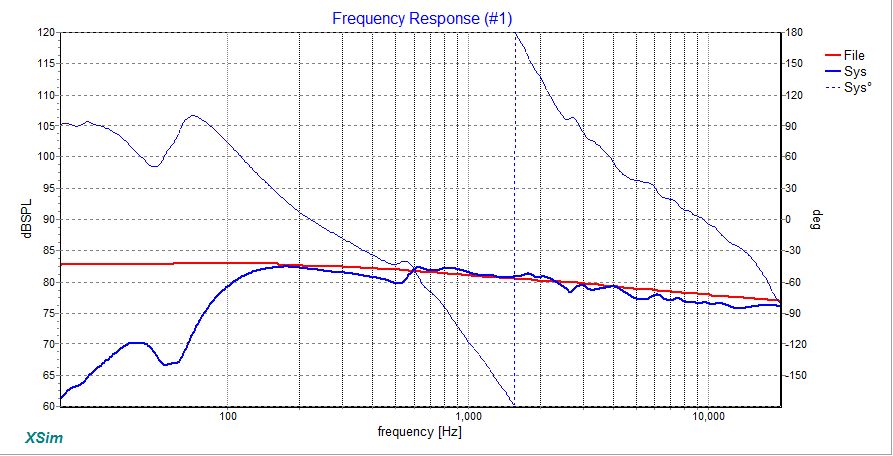
Instead of packing, I have been tweaking the LM-1 to the B&K reference curve. I personally like that curve a lot, but the LM-1 is eminently customizable. If you find it too dull, change it.
Still, here's the comparison of the LM-1 to the B&K curve:

All looks very nice, Erik.
I was simming this today. The ferrofluid XT25 60 is quite a different animal from the Non FF XT25 30. Goes lower crossover.
B&O used to do this sort of thing with (easier, IMO, if you can put up with the low impedance) 4 ohm drivers:
The crossover was something like this:
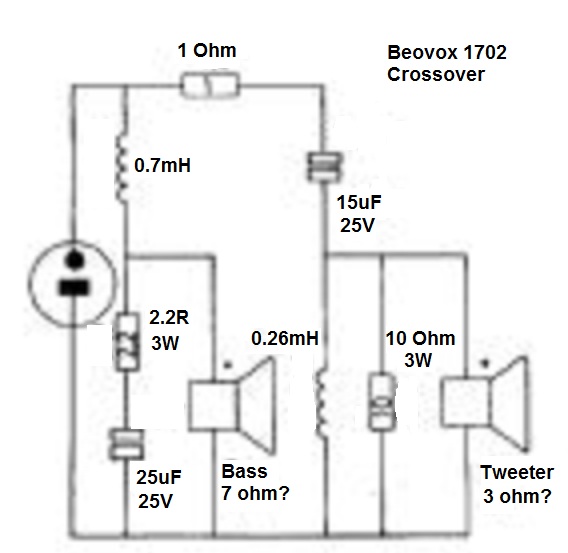
http://www.diyaudio.com/forums/multi-way/147632-classic-monitor-designs-12.html#post2883926
They used a (big) tweeter that could do about 2kHz too.
I liked the tiny Beovox 2702 back in the student day.
I was simming this today. The ferrofluid XT25 60 is quite a different animal from the Non FF XT25 30. Goes lower crossover.
B&O used to do this sort of thing with (easier, IMO, if you can put up with the low impedance) 4 ohm drivers:
The crossover was something like this:

http://www.diyaudio.com/forums/multi-way/147632-classic-monitor-designs-12.html#post2883926
They used a (big) tweeter that could do about 2kHz too.
I liked the tiny Beovox 2702 back in the student day.
Attachments
Thanks, Steve!
This is s opposed to be an educational project. I hope it encourages more music lovers to build their own speakers, as well as encourage listeners to listen to more and different kinds of music, so if you see any glaring mistakes, or places I could add more information please let me know.
After I move I'll be adding all the measurement and simulation files online so it can act as a learning lab.
Best,
Erik
This is s opposed to be an educational project. I hope it encourages more music lovers to build their own speakers, as well as encourage listeners to listen to more and different kinds of music, so if you see any glaring mistakes, or places I could add more information please let me know.
After I move I'll be adding all the measurement and simulation files online so it can act as a learning lab.
Best,
Erik
Yes, the XT25BG60 is an awesome performer when it comes to low frequency extension.
It's documentation is sketchy though. PE claims it's shielded, but that's not in the spec sheet, neither is any information about ferrofluid. I have a feeling there have been so many versions of the XT25 that no one can keep them straight anymore.
What's your source for the ferrofluid in the BG version?
Best,
Erik
It's documentation is sketchy though. PE claims it's shielded, but that's not in the spec sheet, neither is any information about ferrofluid. I have a feeling there have been so many versions of the XT25 that no one can keep them straight anymore.
What's your source for the ferrofluid in the BG version?
Best,
Erik
The ferrofluid issue is just something I saw in an XT25 60 pdf. It was mentioned, whereas it wasn't with the single magnet 30. We had similar problems with SB acoustics, which AFAIK, don't use ferrofluid either.
Maybe I'm wrong on that.
Seems like the 60 has a more rigid surround along with a stronger magnet. But for sure has a much better and smaller impedance bump at Fs (12 ohms versus 20 ohms for the 30). Which makes it friendly to simple filters without all the tricks.
I don't see much of a problem with small woofers anyway. They are so inefficient we have more room to manoeuvre. Efficient tweeters with inefficient woofers are easy, IMO.
Maybe I'm wrong on that.
Seems like the 60 has a more rigid surround along with a stronger magnet. But for sure has a much better and smaller impedance bump at Fs (12 ohms versus 20 ohms for the 30). Which makes it friendly to simple filters without all the tricks.
I don't see much of a problem with small woofers anyway. They are so inefficient we have more room to manoeuvre. Efficient tweeters with inefficient woofers are easy, IMO.
HI DIY'ers,
I'm posting the complete XSim project for the LM-1 speakers here. I have been putting it off for a long time because I kept meaning to update the woofer's FR chart with the port contributions, but it's been six months... and I still haven't gotten around to it, so instead I'm just going to publish it as-is.
I am doing so in the hopes that DIY'ers with little experience and lots of curiosity, can benefit from it. The design and this file are free of charge, so please no requests for distortion plots at blah blah blah. You get what you pay for and that's all you are getting. And, it's free.
You get what you pay for and that's all you are getting. And, it's free.
Please enjoy, I look forward to hearing the kind, and thoughtful replies of the DIY community, and I encourage alternate crossover designs.
As usual, my measurements attempt to be far-field. That may drive most of you nuts. Sorry, it's how I roll.
Best,
Erik
I'm posting the complete XSim project for the LM-1 speakers here. I have been putting it off for a long time because I kept meaning to update the woofer's FR chart with the port contributions, but it's been six months... and I still haven't gotten around to it, so instead I'm just going to publish it as-is.
I am doing so in the hopes that DIY'ers with little experience and lots of curiosity, can benefit from it. The design and this file are free of charge, so please no requests for distortion plots at blah blah blah.
Please enjoy, I look forward to hearing the kind, and thoughtful replies of the DIY community, and I encourage alternate crossover designs.
As usual, my measurements attempt to be far-field. That may drive most of you nuts. Sorry, it's how I roll.
Best,
Erik
Attachments
Last edited:
I can finally see where all of the arguments and heat about this design are coming from, I should have seen this sooner and replied. I apologize for not being more awake and seeing this discrepancy sooner.
I've made a mistake in not fully explaining the LM-1 Bookshelf speakers are actually meant for bookshelves and that has caused a lot of head scratching.
The XSim simulations have been completely accurate to this use, though it still remains to be proven if the actual sensitivity is correct. The measured sensitivity of the finished design is probably closer to 85 dB due to variations in simulated vs. actual but I lack an environment to retest for a while. Still, being in a bookshelf changed everything, so the usual arguments about BSC and it's losses no longer apply either. Win-win say I.
You may not like this approach, but like Alison, I modified my measurements and design practices according to where I intended to put the speakers. You may also think that I still should have sacrificed some efficiency for bass extension. Happy to see others take on that simulation with that in mind to show how this is done. Also happy to use this as a compare-and-contrast project to show different goals require different approaches and yield different benefits.
I'm enclosing an updated XSim file with the port contributions blended into the woofer FRD file.
I've made a mistake in not fully explaining the LM-1 Bookshelf speakers are actually meant for bookshelves and that has caused a lot of head scratching.
The XSim simulations have been completely accurate to this use, though it still remains to be proven if the actual sensitivity is correct. The measured sensitivity of the finished design is probably closer to 85 dB due to variations in simulated vs. actual but I lack an environment to retest for a while. Still, being in a bookshelf changed everything, so the usual arguments about BSC and it's losses no longer apply either. Win-win say I.
You may not like this approach, but like Alison, I modified my measurements and design practices according to where I intended to put the speakers. You may also think that I still should have sacrificed some efficiency for bass extension. Happy to see others take on that simulation with that in mind to show how this is done. Also happy to use this as a compare-and-contrast project to show different goals require different approaches and yield different benefits.
I'm enclosing an updated XSim file with the port contributions blended into the woofer FRD file.
Attachments
Last edited:
I'm adding the actual measured response, but I guarantee the level was off. 
I get sloppy when doing full system measurements, as opposed to driver measurements, sorry.
You will also notice significant ripple between the woofer and port. This did not show up in enclosure simulations, but it's real. I think the actual port ended up tuned a little too low for some reason. The latest XSim file I uploaded was made to match.
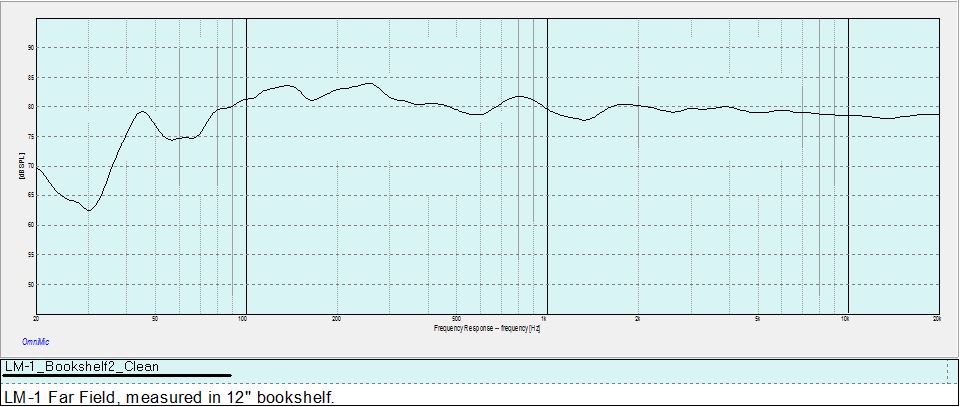
I get sloppy when doing full system measurements, as opposed to driver measurements, sorry.
You will also notice significant ripple between the woofer and port. This did not show up in enclosure simulations, but it's real. I think the actual port ended up tuned a little too low for some reason. The latest XSim file I uploaded was made to match.
Attachments
Last edited:
Very interesting project. You don't often see bookshelf speakers that are actually designed for use on bookshelves, so nice to see an entry into an under-served club.
It certainly has a very extended LF response, but I'd be wary about taking any of the XT25 / R2604 / R3004 / R2904 family very low. Excellent designs all, but they only have radiating area equivalent to a 3/4in dome and they are best treated as such -HD levels are not great below about 2KHz, as Zaph pointed out some years ago. The high end Revelator version can be pushed a little harder on account of its more advanced motor design (for nearly 7 times the price), but they aren't tweeters that are especially well suited to low XO frequencies.
Yes, the XT25BG60 is an awesome performer when it comes to low frequency extension.
It certainly has a very extended LF response, but I'd be wary about taking any of the XT25 / R2604 / R3004 / R2904 family very low. Excellent designs all, but they only have radiating area equivalent to a 3/4in dome and they are best treated as such -HD levels are not great below about 2KHz, as Zaph pointed out some years ago. The high end Revelator version can be pushed a little harder on account of its more advanced motor design (for nearly 7 times the price), but they aren't tweeters that are especially well suited to low XO frequencies.
Last post for a while, here is the XSim (blue) vs. actual (green) measurements on a single chart. Levels offset for clarity and not absolutely correct.
XSim simulation uses gated far-field for the woofer down to about 600 Hz. Below that close miked woofer and port, blended based on far-field measurements. The dip you see around 500Hz in the simulated (blue) trace is not an artifact of bad splicing. It's real. When you measure the woofer alone in close or far-field it re-appears, and makes a very convenient splice point.
It's real. When you measure the woofer alone in close or far-field it re-appears, and makes a very convenient splice point.
The green trace is measured, far-field, I don't rmember the resolution, but the chart I posted above was smoothed to 1/6th octave. This is proably 1/12 or 1/24th octave.
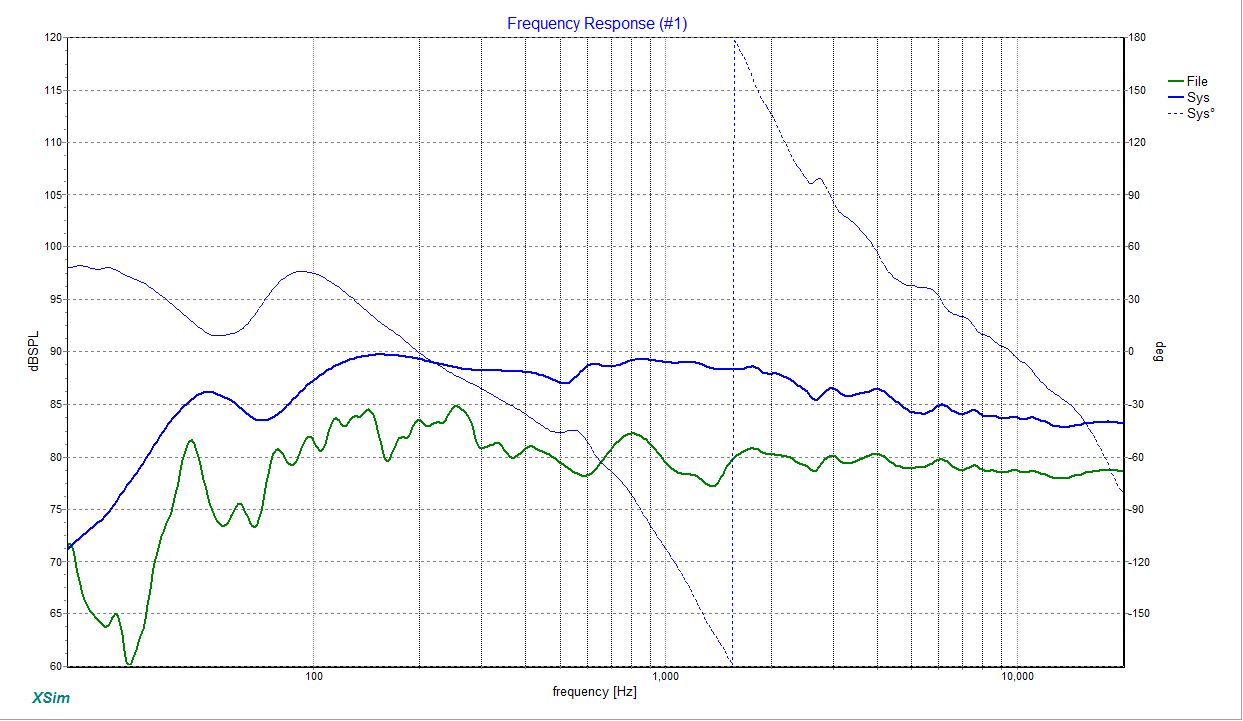
XSim simulation uses gated far-field for the woofer down to about 600 Hz. Below that close miked woofer and port, blended based on far-field measurements. The dip you see around 500Hz in the simulated (blue) trace is not an artifact of bad splicing.
The green trace is measured, far-field, I don't rmember the resolution, but the chart I posted above was smoothed to 1/6th octave. This is proably 1/12 or 1/24th octave.

Last edited:
Yes, the XT25BG60 is an awesome performer when it comes to low frequency extension.
It's documentation is sketchy though. PE claims it's shielded, but that's not in the spec sheet, neither is any information about ferrofluid. I have a feeling there have been so many versions of the XT25 that no one can keep them straight anymore.
What's your source for the ferrofluid in the BG version?
Best,
Erik
According to the Tymphany spec sheet published by Falcon Acoustics the BG60 does not use ferrofluid. Peerless Vifa XT25BG60-04 Tweeter
I think PE assumed it to be shielded because of the double magnet while the manufacturer stated the double magnet is there to increase efficiency and reduce distortion but does not provide shielding.
- Status
- This old topic is closed. If you want to reopen this topic, contact a moderator using the "Report Post" button.
- Home
- Loudspeakers
- Multi-Way
- The LM-1 DIY Speaker is Available
